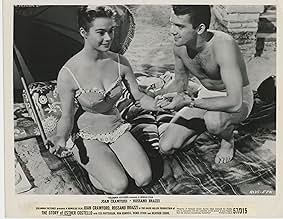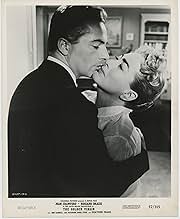Aggiungi una trama nella tua linguaEighteen-year-old Esther has been deaf and blind since the accident which killed her mother. Wealthy Margaret Landi, a native of Esther's village in Ireland, is talked into helping to educat... Leggi tuttoEighteen-year-old Esther has been deaf and blind since the accident which killed her mother. Wealthy Margaret Landi, a native of Esther's village in Ireland, is talked into helping to educate and possibly heal Esther. Margaret grows to love Esther as a daughter, but finds Esther'... Leggi tuttoEighteen-year-old Esther has been deaf and blind since the accident which killed her mother. Wealthy Margaret Landi, a native of Esther's village in Ireland, is talked into helping to educate and possibly heal Esther. Margaret grows to love Esther as a daughter, but finds Esther's innocence threatened by sleazy promoters--and her own sleazy ex-husband.
- Regia
- Sceneggiatura
- Star
- Ha vinto 1 BAFTA Award
- 1 vittoria e 3 candidature totali
Recensioni in evidenza
The grim determination she brought to every role at this late stage in her career remains tauter than ever. As a wealthy American visiting her birthplace in Ireland, she is nudged by the local Padre to look in on poor Esther (Heather Sears), a girl rendered blind and deaf by the explosion of a grenade left over from the "troubles." and living in squalid poverty. Of course Crawford takes Esther back to America, where she finds her the best schools for those similarly afflicted. Soon, the heart-wrenching tale reaches the press, at the same time luring Crawford's long-lost husband (Rossano Brazzi) out of the hole he's been hiding in.
Implausibly, Crawford falls for him all over again, and succumbs to his grandiose schemes for national and European fund-raising rallies for the "Esther Costello Fund," a racket for his self-aggrandizement. He also drinks a lot and starts stealing peeks at the blind Esther slipping in and out of her clothes. (She's busting out of the schoolgirlish frocks and ribbons she's given to dress in.)
Along happens a young reporter who's also smitten with Esther but who starts suspecting that the racket is not on the up and up. From then on it's a race to see whether Brazzi's financial chicanery or his unhealthy interest catches up with him. Crawford does, however, and ends the melodrama a la Thelma Jordon.
The distinctive and responsive score is by Georges Auric, and Jack Clayton gets an odd credit that suggests he had more to do with the movie than its nominal director. The story is certain offbeat and interesting enough, but its social comment invariably defers to the lures of heavy melodrama. The film reaches a crescendo when Brazzi learns that Esther has been left alone; he slithers to her bedside while thunder crashes and the French doors blow open to let a torrent of rain into the room...You get the picture. It's the kind of touch that's effective to watch but which undermines any claim to a serious exploration of the unusual subject matter. It's that kind of literal heavy-handedness that led Lenny Bruce to devise an irreverent (and very funny) routine on this movie's story line.
Part "Miracle Worker" and part "Elmer Gantry" (this film predates both), "The Story of Esther Costello" wavers between instructional (how to teach the blind- deaf) and exploitive (how to bilk the public). An odd film for 1957 and Crawford's last starring film of the 50s. She wouldn't return to the screen until "What Ever Happened to Baby Jane?"
Well 53-year-old Crawford looks great and turns in a solid performance. Brazzi plays the snaky husband who turns out to be much more rotten than you'd guess. Heather Sears plays Esther as though she is a disciple of Jennifer Jones as Bernadette. Ron Randell is good as the crabby press agent; Lee Patterson is good as the boy friend; Bessie Love (one of Crawford's silent-film pals from 1920s MGM) is funny as a gallery patron; Fay Compton plays the head nun; Dennis O'Dea is the priest; Estelle Brody plays Tammy; John Loder is a friend. Good cast in a solid but too-long film.
The violent ending is quite jarring and unexpected.
Crawford's melodramatic persona was a safe bet for her since Mildred Pierce (1945) for which she won the Academy Award. This was the making of Crawfod as well as the breaking. She seemed to be stuck in the character of Mildred Pierce from then on in.
As for her co-star Rossano Randi, it was a brave move for him to take on the part of the slime ball rapist, embezzler, and exploiter. It was a risk for his career as an actor, and it could have the affect of stereotyping people from Latin extraction.
The part of the title role; as in Esther Costello, was played exceeding well by Heather Sears. All of her acting was conveyed through emotion and gestures alone. This was especially played well in her vulnerable scenes, such as that of the rape victim.
The fact that Esther overcomes many of her obstacles, the narrative of the story turns victimhood into survival. A powerful theme with a message of hope. However the end of the film, where Esther recovers from her disabilities, is too much.
If the viewer can overcome the melodrama of this film, it has some powerful messages in it. For that reason it's worth a look at.
Lo sapevi?
- QuizJoan Crawford, then on the Pepsi-Cola board of directors, demanded that product placement shots be included in all her films of this era. It is prominently displayed on signs in an airport lobby.
- BlooperWhen the cottage explodes in the beginning of the movie, the right wall falls, revealing the plywood set construction underneath. The stone walls are just paper covering over wood.
- ConnessioniFeatured in Film Preview: Episodio #1.4 (1966)
I più visti
- How long is The Story of Esther Costello?Powered by Alexa
Dettagli
- Data di uscita
- Paese di origine
- Lingua
- Celebre anche come
- The Story of Esther Costello
- Luoghi delle riprese
- Azienda produttrice
- Vedi altri crediti dell’azienda su IMDbPro
- Tempo di esecuzione
- 1h 43min(103 min)
- Colore
- Proporzioni
- 1.85 : 1



































